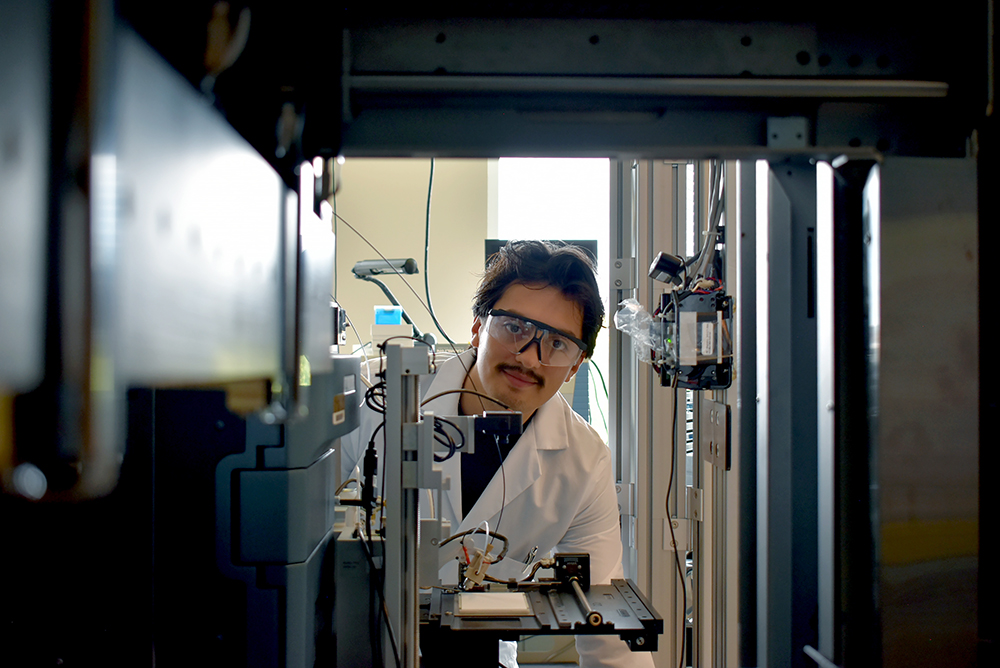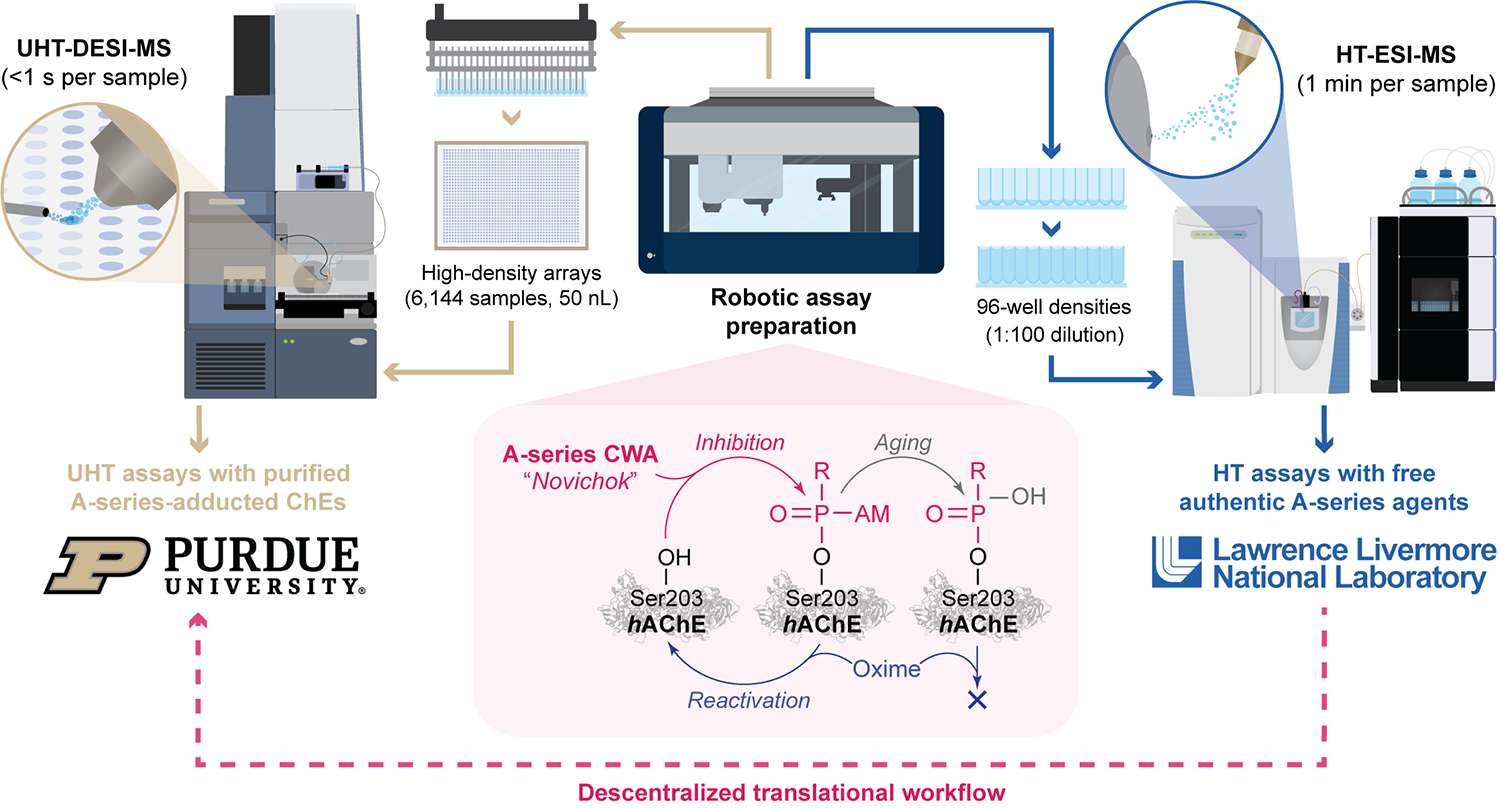Safety threats revealed by mass spec
2025-07-30

Purdue researchers are using mass spectrometry to quickly characterize and counteract highly toxic nerve agents
Compounds commonly known as “Novichoks”, or A-series nerve agents, are a family of chemical warfare agents (CWA) which are acutely toxic chemicals. They are very potent inhibitors of an enzyme essential to terminating nerve impulse transmission. It is likened to a switch that helps turn off muscle control from the ‘contract’ state to the ‘relax.’
When exposed to CWAs, the enzyme is inhibited, leading to nerve overstimulation. This essentially means one would get stuck in a constant ‘contract’ state across one’s muscles, as the ‘relax’ response is prevented, even in those muscles that regulate unconscious actions. Thus, exposure to these agents can quickly induce paralysis and then lead to death by asphyxiation or cardiac arrest if untreated.
Little is broadly known about these A-series nerves agents, including many of their basic physical and chemical properties. A team of researchers from Purdue and the Forensic Science Center (FSC) at Lawrence Livermore National Laboratory (LLNL) have created a quick way to study these nerve agents using mass spectrometry (MS). They have recently published their finding in Proceedings of the National Academy of Sciences of the United States of America (PNAS). The characterization of the A-series agents provides a solid experimental basis for the efficient development of countermeasure candidates against them.
“The A-series family is interesting because it is not very well characterized, with most of the reports on them relying on anecdotal evidence which might have exaggerated their toxicity or computational studies with little experimental support,” said lead author Nicolás M. Morato, research assistant professor at Purdue University. “For a while, even their reported structures were incorrect, until scheduled by the Chemical Weapons Convention about five years ago. A-series agents ‘rose to fame’ recently, when news sources reported their involvement in the high-profile assassination attempts in Salisbury in 2018.”
Graham Cooks, the Henry Bohn Hass Distinguished Professor of Chemistry at Purdue University, is a co-principal investigator. The technology underlying this discovery, ultra-high-throughput desorption electrospray ionization (DESI) MS, was developed in his group over the past 20 years, starting with the development of DESI. Both Cooks and Morato are members of the Purdue Institute for Cancer Research at Purdue University. All other authors are part of the FSC at LLNL.
Nerve agents were handled only at the FSC at LLNL, which is a specialized facility prepared and certified to do so as a United States Designated Laboratory for the Organization for the Prohibition of Chemical Weapons (OPCW).

“We set up to quantitatively characterize three of these agents (A-230, A-232 and A-234) which are all structurally related,” said Morato. “This characterization implied studying how potent they are as inhibitors of acetylcholinesterase, but also what happens after they inhibit the enzyme. This is important as nerve agents can either age and trap the enzyme irreversibly, or be removed by an antidote, to reactivate it. To characterize these processes, we developed label-free methodologies based on high-throughput mass spectrometry.”
These technologies allow rapid analysis of the biological assay samples needed to study these acutely toxic compounds, without any of the complications or interferences that are commonplace in traditional biochemical assays.
“When I say rapidly, I mean it. We are talking of platforms that can analyze a sample in as fast as a third of a second. You could blink and miss it,” said Morato. “The fastest of these systems was developed at Purdue University initially through the DARPA Make It program and later the NIH NCATS ASPIRE initiative. As part of this NCATS program we have put together a second-generation system in a collaborative effort with NCATS as well as with Waters Corporation and Hamilton Robotics, which provides not only ultrafast experiments but also complete automation with a capacity of nearly 100,000 samples per experiment.”
The team first studied the compounds’ inhibitory potency, which in turn reflects their acute toxicity. They found that, contrary to previous reports, these compounds are only as toxic as other well-known chemical warfare agents such as sarin or VX, instead of significantly more potent.
Secondly, in terms of aging, they found that the adducted enzyme is stable, and it does not age to any significant extent at least over the course of a month. There is also no spontaneous reactivation.
“Regarding reactivation and antidote discovery, we screened a library of candidate countermeasures synthesized at LLNL, which include some new candidates that we are reporting for the first time,” said Morato. “Overall, many of them are very effective against a traditional CWA, VX, and its surrogate. For A-series agents on the other hand, although found to be more resistant to countermeasures, we did identify a class of countermeasures that shows activity -at least in laboratory conditions- against them. This was in a way unexpected. There was a general belief, again without much experimental support, that these agents were not reactivatable. However, this discovery now gives us a direction to pursue for the development of more potent countermeasures.”
Ultra-high-throughput DESI-MS, the key technology underlying the discoveries related to A-series agents, has far reaching applications in the drug discovery enterprise. It is being used for a wide variety of applications by researchers at Purdue as well as external collaborators.
Brian Mayer, Deputy Director of the FSC and the study’s co-principal investigator, praised the impact of the work and the enabling technology saying, “our collaboration with Purdue has opened up doors to the counterproliferation community that simply did not exist before. The scale on which we can now understand emergent threats and the acceleration with which we can identify promising countermeasure leads allows us to better respond and anticipate whatever dangers may present themselves in the future. This technology and our continued work with Purdue are true assets to national security.”
“We intend to continue this work towards the successful development of more effective countermeasures. For this we will leverage the unique capabilities of the DESI technology, which allows not only for the very rapid analysis of biosamples, but also for the on-the-fly synthesis of new molecules,” said Morato. “In this way, we can use the same technology we used to characterize these agents to very quickly synthesize new candidate countermeasures based on the scaffold we found active and test their activity in a label-free fashion. Thanks to its complete automation we can then iterate this cycle over and over to obtain a potent lead for further downstream testing. Moreover, the workflow demonstrated in this collaboration with LLNL provides an agile and robust approach for the characterization of and response to emerging threats through decentralized translational science. Such decentralized research using Purdue’s unique high-throughput analytical and synthetic technology has the potential to accelerate also the early drug discovery endeavor, one of the goals of the NCATS ASPIRE program we are part of and through which we developed the new-generation platform used in this study.”
This research is made possible due to the ultra-high-throughput DESI-MS technology available at Purdue University for internal and external researchers as a facility within the Bindley Bioscience Center, a core facility of the NIH-funded Indiana Clinical and Translational Sciences Institute (CTSI).
This work was funded by the LLNL Laboratory Directed Research and Development (LDRD) program (22-ERD-007). The ultra-high-throughput technology used in the study was developed with support from the National Center for Advancing Translational Sciences (NCATS) through the New Chemistries for Undrugged Targets through ASPIRE (A Specialized Platform for Innovative Research Exploration) Collaborative Research Program (UG3 TR004139). The team also acknowledged support from the Purdue Institute for Cancer Research (NIH grant P30 CA023168).
About Purdue Chemistry
The Tarpo Department of Chemistry is internationally acclaimed for its excellence in chemical education and innovation, boasting two Nobel laureates in organic chemistry, the #1 ranked analytical chemistry program, and a highly successful drug discovery initiative that has generated hundreds of millions of dollars in royalties. chem.purdue.edu.
Contributors:
Nicolás M. Morato, Research Assistant Professor, Purdue Institute for Cancer Research
Graham Cooks, Henry Bohn Hass Distinguished Professor, Department of Chemistry
Brian Mayer, deputy director of the Forensic Science Center at Lawrence Livermore National Laboratory
Graphic provided by Morato
Written and photo by Cheryl Pierce, Purdue University College of Science